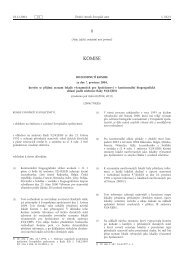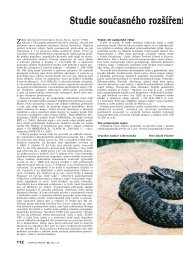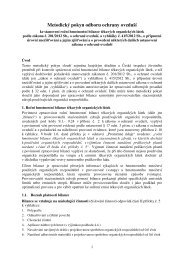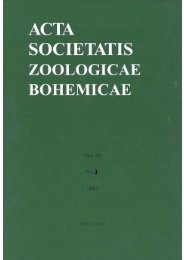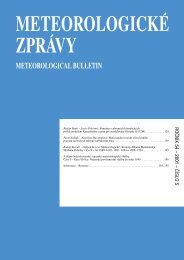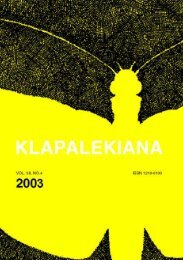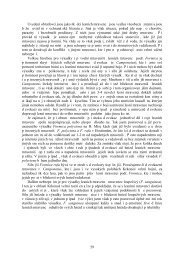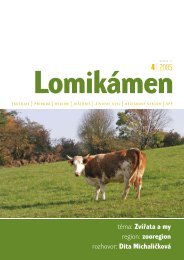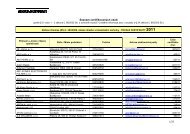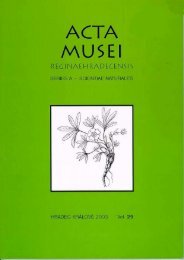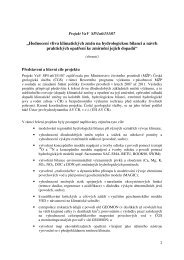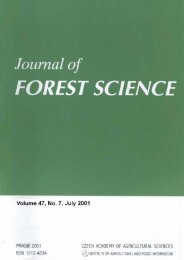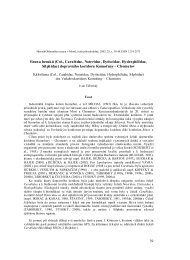Distribution and taxonomy of some Synapsis species, with ...
Distribution and taxonomy of some Synapsis species, with ...
Distribution and taxonomy of some Synapsis species, with ...
You also want an ePaper? Increase the reach of your titles
YUMPU automatically turns print PDFs into web optimized ePapers that Google loves.
COMMENTS. Hope (1831) briefly described Silpha melanura from “Nepaul”. Portevin (1922) transferred<br />
S. melanura to Eusilpha Semenov, 1891, based on written comments on the type specimen<br />
received from M. H. E. Andrewes. Emetz & Schawaller (1975) described Silpha nakanei from<br />
Nepal: Khurumsang, based on a single male specimen. Later, Schawaller (1982) published further<br />
records <strong>of</strong> S. nakanei <strong>and</strong> commented that this <strong>species</strong> only occurs in the Kathm<strong>and</strong>u valley <strong>and</strong><br />
Nuwakot distr., <strong>and</strong> compared this <strong>species</strong> <strong>with</strong> other three endemic Nepalese <strong>species</strong> <strong>of</strong> Silpha<br />
Linnaeus, 1758.<br />
I have compared the holotype <strong>of</strong> S. melanura <strong>with</strong> recently collected material from Nepal <strong>and</strong><br />
<strong>with</strong> the description <strong>of</strong> S. nakanei, <strong>and</strong> found both taxa identical in all diagnostic characters<br />
(according to the key in Schawaller 1982) – elongate body; heavily punctate head in the region<br />
between eyes; distinctly puncate median part <strong>of</strong> pronotum; elytra <strong>with</strong> distinctly developed ridges,<br />
separated by intervals <strong>of</strong> equal width.<br />
Consequently, I consider Silpha nakanei Emetz et Schawaller, 1975 as a junior subjective<br />
synonym <strong>of</strong> Silpha melanura Hope, 1831.<br />
310<br />
Silpha obscura obscura Linnaeus, 1758<br />
Silpha obscura Linnaeus, 1758: 361.<br />
Silpha costata Ménétries, 1832: 167 (non Brullé, 1836: pl. II, fig. 11); confirmed synonymy.<br />
Silpha striola Ménétries, 1832: 168; confirmed synonymy.<br />
Silpha godarti Reiche, 1861: 369; syn. n.<br />
Silpha obscura var. simplex Semenov, 1891: 297; syn. n.<br />
Silpha nitida Portevin, 1907: 252 (non Faldermann, 1835a: 220); syn. n.<br />
Silpha obscura latialis Depoli, 1931: 14; syn. n.<br />
Silpha obscura ablattaroides Portevin, 1943: 48; syn. n.<br />
Silpha obscura mongolica Schawaller, 1980: 9 (non Faldermann, 1835b: 365); syn. n.<br />
TYPE MATERIAL EXAMINED. LT male <strong>of</strong> Silpha costata (ZISP), labelled “Cauc. [p, orange paper] // costata / Ménétr. [hw,<br />
Ménétries’s MS, label <strong>with</strong> printed double black frame] // ZOOLOGICAL INSTITUTE / Russian Academy / <strong>of</strong><br />
Sciences, / ST. PETERSBURG, RUSSIA [p, yellow label] // LECTOTYPE (male symbol) / Silpha / costata<br />
Ménétries, 1832 / Jan R%ži!ka det. 2002 [p, red label] // Silpha / obscura obscura / Linnaeus, 1758 / Jan R%ži!ka det.<br />
2002 [p]”.<br />
LT male <strong>of</strong> Silpha striola (ZISP), labelled “Cauc. [hw] // striola / Ménétr. [hw, Ménétries’s MS, label <strong>with</strong><br />
printed double black frame] // ZOOLOGICAL INSTITUTE / Russian Academy / <strong>of</strong> Sciences, / ST. PETERSBURG,<br />
RUSSIA [p, yellow label] // LECTOTYPE (male symbol) / Silpha / striola Ménétries, 1832 / Jan R%ži!ka det. 2002<br />
[p, red label] // Silpha / obscura obscura / Linnaeus, 1758 / Jan R%ži!ka det. 2002 [p]”.<br />
HT male <strong>of</strong> Silpha obscura var. simplex (ZISP), labelled “Sibir. occ. [p] / Kolb [hw, green label] // Silpha<br />
obscura, var. / simplex m. (in litt.) / (male symbol) un. cAS.XI.[18]90 [hw, Semenov’s MS, label <strong>with</strong> light blue<br />
lines <strong>and</strong> columns] // Coll. Semenov-Tian-Shansky [p] // ZOOLOGICAL INSTITUTE / Russian Academy / <strong>of</strong><br />
Sciences, / ST. PETERSBURG, RUSSIA [p, yellow label] // HOLOTYPE (male symbol) / Silpha obscura / var.<br />
simplex Semenov, 1891 / label added by Jan R%ži!ka, 2002 [p, red label] // Silpha / obscura obscura / Linnaeus, 1758<br />
/ Jan R%ži!ka det. 2002 [p]”.<br />
LT male <strong>of</strong> Silpha nitida (MNHN, coll. M. Pic / G. Portevin; here designated), labelled “Kashmir [hw] // Silpha<br />
/ nitida mihi (male symbol) [hw, Portevin’s MS] // s. esp. de / obscura / L. [hw, Pic’s MS] // LECTOTYPE (male<br />
symbol) / Silpha / nitida Portevin, 1907 / Jan R%ži!ka design. 2002 [p, red label] // Silpha / obscura obscura /<br />
Linnaeus, 1758 / Jan R%ži!ka det. 2002 [p]”; PLT 1 female (BMNH), labelled “Type [round label <strong>with</strong> red margin]<br />
// Kashmir [hw] // Silpha / nitida Port. [hw] // Andrewes / Request / B. M. 1922–221. [p] // PARALECTOTYPE<br />
(female symbol) / Silpha / nitida Portevin, 1907 / Jan R%ži!ka design. 2002 [p, red label] // Silpha / obscura obscura<br />
/ Linnaeus, 1758 / Jan R%ži!ka det. 2002 [p]”; PLT 1 female (BMNH), the same labels except “Co- / type [round<br />
label <strong>with</strong> green margin]”.<br />
LT female <strong>of</strong> Silpha obscura latialis (IEUS; here designated), labelled “UMBRIA / Poggio Mirteto / G. Leoni<br />
[p] // v. [sic!] latialis / m. [hw, Depoli’s MS] / G. Depoli det. [p] // LECTOTYPE (female symbol) / Silpha obscura<br />
/ latialis Depoli, 1931 / Jan R%ži!ka design. 2002 [p, red label] // Silpha / obscura obscura / Linnaeus, 1758 / Jan<br />
R%ži!ka det. 2002 [p]”.



